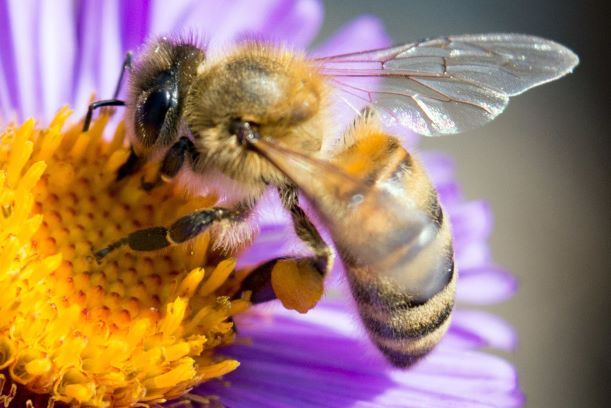Did you know that you could make a valuable contribution to supporting native bee populations simply by planting a variety of bee-friendly plants in your garden?
Attracting bees and other pollinators into your garden is very important, as these valuable insects pollinate so many of the fruits and veggies we grow. In fact, over 75% of the world’s flowering plants rely on pollinators like bees to reproduce, so without them, the veggie patch and orchard would look pretty bare!
For a bee-friendly garden, include a range of flower sizes and shapes from tubular to shallow open blooms to cater for the diversity of native bees that range in size from 2mm to 24 mm and have both long and short tongues.
There are plenty of plants which will attract bees and other pollinators but here are some of the very best plants to attract bees to your garden:
1. Annuals
[img attachment=”4790″ size=”large” align=”alignnone” linkto=”file” /]
Annuals add pizzazz and bucket loads of pollen and nectar sources to draw more butterflies, bees, and other pollinators to your garden. Amongst the top annuals for attracting bees is cosmos – with its beautiful feathery foliage and flowers of pink white or orange.
If you’re looking for a border plant that will get the bees bussing in your garden, alyssum will be the answer! Their low-growing masses of honey-scented white blossoms are a pollinator magnet!
Other bee-attracting annuals include Queen Anne’s Lace, calendula, phacelia and daisies.
2. Perennials
[img attachment=”4791″ size=”large” align=”alignnone” linkto=”file” /]
Daisies are easy to grow and can fit in any type of garden – large or small. Their shallow flowers provide readily accessible nectar and pollen to native bees. Both native species (e.g. the Cut Leaf Daisy Brachyscome and the Everlasting Daisy Bracteantha) and exotic species (e.g. the African Daisy Osteospermum and the Seaside Daisy Erigeron) are popular with native bees.
Plants from the salvia family are particularly attractive to blue-banded bees. These plants will grow in a container, while the hundreds of varieties of salvia flowers will brighten up your garden with a minimum of care. Salvia nemorosa, a very hardy and reliable small perennial, is good at the front of a sunny border and holds purple bracts even after the blue flowers are finished. It attracts a mix of carder bumblebees, honey bees and some solitary bees (and even wasps!).
If you’ve never had penstemon in your garden, then now is a great time to add one. All penstemon are good for bees and butterflies! These plants will add a wonderful burst of colour to your garden from spring to late autumn.
3. Herbs
[img attachment=”4792″ size=”large” align=”alignnone” linkto=”file” /]
Growing herbs is a win-win! Apart from the benefit of having herbs on tap for your cooking endeavours, many of them are also a favourite with bees. A particular favourite of the native Blue Banded Bee is lavender, which is high in nectar and flowers all-year-round.
Native bees also love other herbs such as oregano, basil, thyme, sage, rosemary, lemon balm, parsley and mint.
TIP: Bees prefer yellow and blue flowers, so factor these into your selection.
4. Native Trees and Shrubs
[img attachment=”4793″ size=”large” align=”alignnone” linkto=”file” /]
Gum blossoms from trees in your local area are a fabulous source of food for native bees. If you don’t have much room, a red flowering gum (Ficifolia) can be a good option and will delight you will an abundance of spring flowers.
For a smaller tree or shrub, tea tree (Leptospermum) has beautiful white, pink and red flowers that bloom in early summer. Tea Tree plants are also great as a screening plant and the essential oils can be used to make candles, soaps and other items.
Native bees are drawn to grevillea, which is available in a wide range of sizes that will suit most gardens – from ground covers to tall shrubs and trees. They flower most of the year and produce a high amount of nectar that also attracts birdlife to your garden. Grevillea Pink Surprise is one of our favourites, with large peachy-pink blush flowers above fast-growing glossy green foliage.
Finally, Bottlebrush callistemon, the most common and widely grown bottlebrush, produces a mass of nectar and pollen-rich bright red flowers that appear in summer and autumn. They are a popular choice for Australian gardens as they can be used as hedges and screen-plants – ranging in size from 50cm to 4 metres tall. Crimson Rosellas will also visit to feed on the seed.
DID YOU KNOW? Flowering plants will not just attract bees – they’ll also attract other beneficial insects that are the natural predators of pests such as aphids.
Need help with selecting the best plants to attract bees?
If you would like to get a question answered about selecting plants that will attract bees – or access our garden consultancy services – give us a call to arrange a free consultation.
[img attachment=”4075″ size=”large” align=”alignnone” linkto=”custom” url=”https://mosarte.com.au/contact-us/” /]
